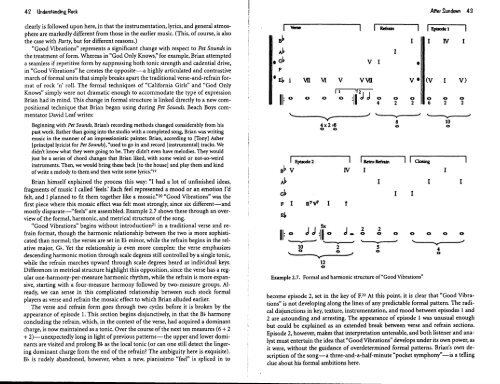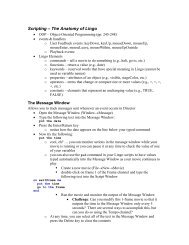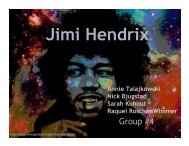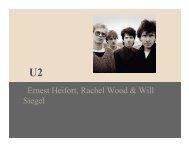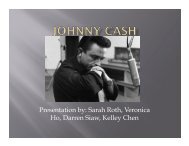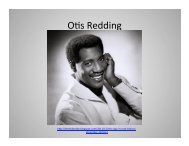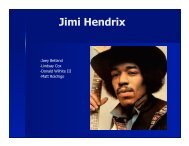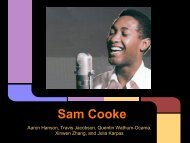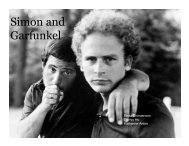After Sundown: The Beach Boys' Experimental ... - Scott D. Lipscomb
After Sundown: The Beach Boys' Experimental ... - Scott D. Lipscomb
After Sundown: The Beach Boys' Experimental ... - Scott D. Lipscomb
Create successful ePaper yourself
Turn your PDF publications into a flip-book with our unique Google optimized e-Paper software.
38 Understanding RockG: ‘I ii7Example 2.5. “California Girls,” harmonic structure of refrain3-4, and is drawn instead to the connections between these units-tomeasures 2-3,4-5, and 6-7. It is at these points where the expectations of the I-ii7progression of the model (i.e., I-ii7. . . V!) are thwarted and where harmonic structureseems to push apart the formal unit.8 Though the refrain is actually no longerthan expected given the hypermetrical behavior of the rest of the song, it gives theimpression of being something larger. <strong>The</strong> harmonic innovations of the refrain simplyreverberate far longer than the more prosaic progression of the verses.<strong>The</strong> album that all but announced the renunciation of their early work was PetSounds (1966).9 Even the title, in comparison with that of their previous album,Summer Days (and Summer Nights!!), demonstrates a curious detachment fromtheir usual themes.10 <strong>The</strong> most obvious stylistic difference is the nature of the lyrics.Not a single reference to surfing or hotrodding appears in any song; instead, thealbum works out in song-cycle fashion a complex treatment of love and loneliness,moving between these two with an attitude that itself alternates between naive fantasyand budding cynicism. Though the subject matter is considerably removedfrom their earlier topics, the use of current and faddish idiom in the lyrics is familiar.This time, however, the specialized language of beach and garage is replaced bythat of the nascent California counterculture of the 1960s, spiced with some leftoverbeatnik lingo.Accompanying this change in the style of the lyrics is a broadening of the musicalpalette. Taking a cue from Phil Spector, Brian explored all manner of unusualinstrumental combinations and percussion instruments.11 ‘Caroline No,” for example,seems to use harpsichord, guiero, alto flute, electric bass, and- outrageouslyanempty and overturned plastic water jug as percussion instrument.12 <strong>The</strong> showcasingof these unusual combinations was done at the expense of the traditionaltwo-guitar, bass, and drum-set arrangement. <strong>The</strong> close vocal harmonies, however,.<strong>After</strong> <strong>Sundown</strong> 39the <strong>Beach</strong> Boys’ central expressive vehicle, are still prominent, and they now findmore congenial and expansive surroundings among the ambitious lyrical and accompanimentalstyles.Pet Sounds was a showcase for a new style of lyrics and instrumentation. In termsof the structure of the songs themselves, there is comparatively little advance fromwhat Brian had already accomplished or shown himself capable of accomplishing.Most of the songs use unusual harmonic progressions and unexpected disruptionsof hypermeter, both features that were met in “Warmth of the Sun” and “Don’t BackDown.”One of the songs on the album, however, does have a remarkable formal characteristicthat can best be appreciated in light of the technique of “California Girls.”“God Only Knows,” because of its avoidance of root-position tonic and lack ofcadential drive, seems the ultimate expression of the form-expanding illusions thatBrian created in “California Girls.” Example 2.6a presents the harmonic structure ofthe verse and refrain using figured-bass symbols and some rough reahations of thechords. A number of features of this structure are remarkable. First, note the extraordinarilyweak versions of tonic favored in the progression. Ostensibly set in Emajor, there is not a single root-position E-major triad, the position being theprivileged tonic form. (See the neighbor motion at chords five through seven thatprolongs I in E.) Second-and working in tandem with the avoidance of E majorin root position- the highly chromatic nature of the progression militates againstthe influence of E tonic and seems to leave the progression without any tonic support.<strong>The</strong> D-major that opens the verse signals the overall weakness of E tonic, andthis signal is boosted at the folIowing chord, a B-minor triad that in no way is heardas V of E. Finally, in the absence of a strong E tonic, A major seems to fill the vacuumat the tonal center, since it is the chord that begins the refrain, and since it receives astrong tonic charge upon the resolution of the chord preceding the refrain.13 Inaddition, the opening chords of the verse, while nondiatonic to the nominative E-major tonic, are diatonic to<strong>The</strong> competition between E and A for tonic control is made clear during thebreak between verse 2 and the recapitulation of verse 1 lyrics. A bass-line sketch ofthe later portion of that section appears in example 2.6b, along with some analysisof phrase-joining technique. During the second half of the break, the harmonic progressionof the verse is interpolated but transposed to the key of A; the asterisks inboth examples 2.6a and 2.6b show this correspondence. During this interpolation,no words are sung, and the singers are involved in complicated contrapuntal playover the progression-in other words, the allusion to the harmonic structure of theverse is made subtle both by the transposition and by different melodic activity.Only when the music of the now A-major refrain is encountered do the voicesreturn to their familiar words. Yet, at the end of the first sentence of the refrain, theprogression elides with wonderful smoothness into the beginning of the E-majorverse. <strong>The</strong> A-major refrain seems shunted aside as the E-major verse inserts itselfinto the musical flow, an impression conveyed visually by the phrase markingsabove example 2.6b. <strong>The</strong>re is no moment in rock music more harmonically and formallysubtle than this transition. It is the apex of Brian Wilson’s first period of formalexperimentation.


